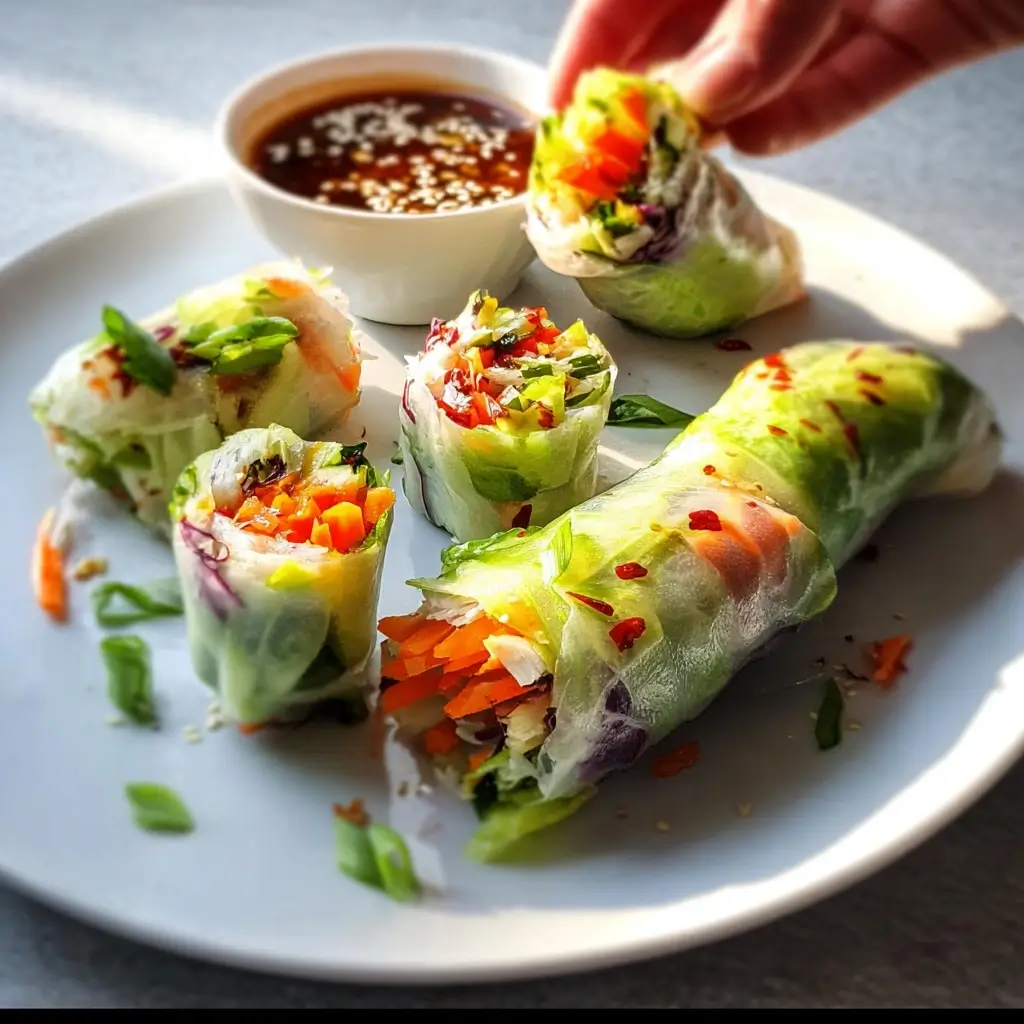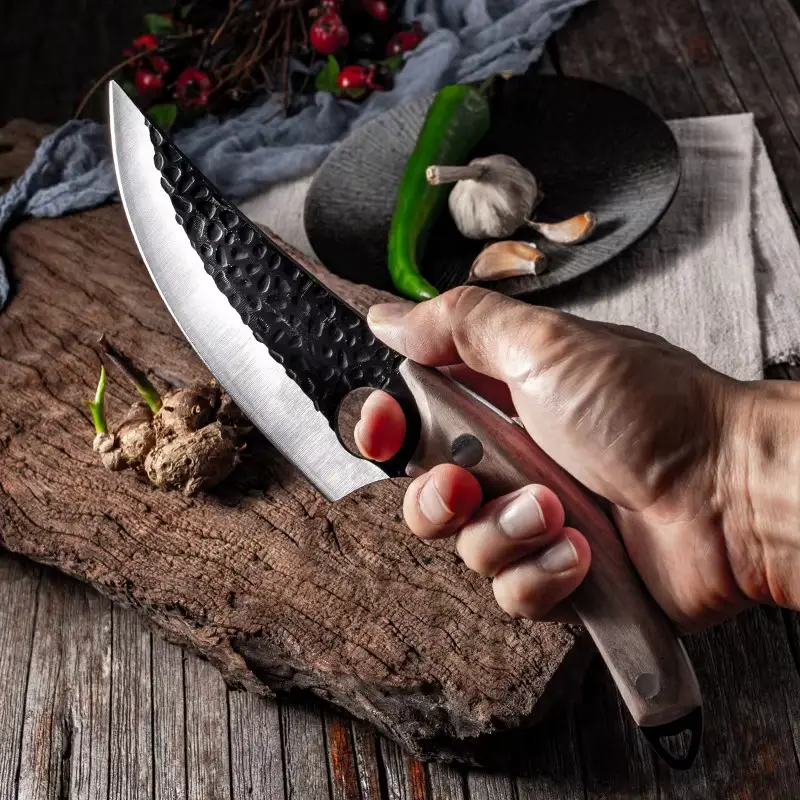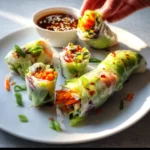Of all the recipes that have become a staple in my kitchen, these Quick Veggie Rice Paper Rolls hold a special place. I remember the first time I made them; it was one of those hectic weeknights where the thought of turning on the oven felt like a monumental task. I needed something fast, something healthy, and something that wouldn’t result in a chorus of sighs from the family. I stumbled upon the idea of fresh spring rolls, and it was a revelation. Setting up a little assembly line of vibrant, crisp vegetables, soft noodles, and fragrant herbs turned dinner from a chore into a fun, interactive activity. The look on my kids’ faces as they successfully rolled their own lumpy-but-loved creations was priceless. That first bite—the soft, slightly chewy wrapper giving way to a burst of fresh crunch and the savory-sweet punch of the peanut dipping sauce—was pure magic. It was light yet incredibly satisfying. Since that day, these rolls have become our go-to for everything from quick lunches and light dinners to impressive-looking appetizers for guests. They are a testament to the fact that healthy, delicious food doesn’t have to be complicated or time-consuming. It’s our little slice of fresh, vibrant, and healthy heaven, wrapped up in a delicate rice paper package.
Ingredients
Here is everything you will need to create these beautiful and delicious vegetable rolls and the accompanying peanut sauce. The key is to have fresh, crisp ingredients prepped and ready to go before you start the assembly process.
For the Veggie Rice Paper Rolls:
- Rice Paper Wrappers (12-15 sheets, 8.5-inch diameter): These are the translucent, brittle discs that become soft and pliable when dipped in water. They are the vessel for all the delicious fillings.
- Rice Vermicelli Noodles (4 ounces): These thin, delicate noodles provide a soft, starchy base inside the rolls, perfectly complementing the crunchy vegetables.
- Large Carrots (2, julienned): Sliced into thin, matchstick-like pieces, they offer a sweet flavor and a fantastic, vibrant crunch.
- Cucumber (1, julienned): Provides a cool, refreshing crispness and a high water content that makes the rolls feel exceptionally fresh.
- Red Bell Pepper (1, thinly sliced): Adds a lovely sweetness, a pop of bright red color, and a satisfyingly crisp texture.
- Butter Lettuce or Romaine (1 small head, leaves separated): The tender leaves act as a soft cushion for the other ingredients and help prevent the sharper veggies from tearing the delicate rice paper.
- Fresh Mint (1 cup, leaves picked): Introduces a bright, cool, and aromatic flavor that is a classic and essential component of fresh spring rolls.
- Fresh Cilantro (1 cup, leaves picked): Adds a zesty, citrusy note that brightens up the entire flavor profile. For those not fond of cilantro, Thai basil is an excellent substitute.
- Optional Protein: For a more substantial roll, consider adding 4 ounces of firm tofu (pressed and pan-fried), cooked shrimp, or even thin slices of cooked beef for a heartier meal.
For the Quick Peanut Dipping Sauce:
- Creamy Peanut Butter (1/2 cup): The rich, nutty, and savory base of the sauce. Use a natural, unsweetened variety for the best flavor control.
- Soy Sauce or Tamari (3 tablespoons): Adds the essential salty and umami depth. Use tamari for a gluten-free option.
- Maple Syrup or Honey (2 tablespoons): Provides a touch of sweetness to balance the saltiness of the soy sauce and the richness of the peanut butter.
- Lime Juice (1 tablespoon, freshly squeezed): A splash of fresh lime juice cuts through the richness and brightens all the flavors with its acidity.
- Warm Water (3-5 tablespoons): Used to thin the sauce to the perfect drizzling or dipping consistency.
- Garlic Clove (1, minced): A small amount of fresh garlic adds a pungent, aromatic kick.
- Sriracha or Chili Garlic Sauce (1 teaspoon, or to taste): For a gentle warmth and a bit of spicy complexity. Adjust the amount based on your heat preference.
Instructions
Follow these step-by-step instructions for a seamless and enjoyable roll-making experience. The secret is in the setup, or “mise en place.”
Step 1: Prepare the Dipping Sauce
Before you begin assembling the rolls, it’s best to make the peanut sauce so the flavors have a moment to meld together. In a small bowl, combine the creamy peanut butter, soy sauce (or tamari), maple syrup, fresh lime juice, minced garlic, and sriracha. Whisk vigorously until the mixture is thick and well-combined. It will likely be very thick at this stage. Begin adding the warm water, one tablespoon at a time, whisking continuously after each addition until you reach your desired consistency. You’re looking for a sauce that is smooth and pourable but still thick enough to cling to the rolls. Set it aside while you prepare the fillings.
Step 2: Cook the Noodles
Bring a medium pot of water to a boil. Add the rice vermicelli noodles and cook according to the package directions, which is typically only 2-4 minutes. They cook very quickly, so keep a close eye on them to prevent them from becoming mushy. Once cooked, drain the noodles immediately and rinse them under cold running water. This stops the cooking process and removes excess starch, preventing them from clumping together. Set aside.
Step 3: Set Up Your Rolling Station
This is the most crucial step for a stress-free assembly process. Arrange all your prepared ingredients in individual bowls or in organized piles on a large cutting board. You should have your julienned carrots, cucumber, sliced bell pepper, lettuce leaves, fresh mint, fresh cilantro, and the cooked vermicelli noodles all within easy reach. This assembly-line setup makes the rolling process smooth and efficient.
Step 4: Prepare the Rice Paper
Fill a large, shallow dish (a pie plate or a large skillet works perfectly) with warm water. The water should be warm to the touch, not hot. If it’s too hot, the rice paper will become overly sticky and tear easily. Place a clean, damp tea towel or a large plastic cutting board on your work surface. A damp surface prevents the rice paper from sticking.
Step 5: Hydrate and Fill the Wrapper
Take one sheet of rice paper and submerge it completely in the warm water for about 15-20 seconds. You want it to be softened and pliable, but not limp. It will continue to soften as you fill it. Carefully lift it from the water, allowing excess water to drip off, and lay it flat on your prepared damp surface.
Step 6: Assemble the Roll
Working quickly, begin layering your ingredients on the bottom third of the wrapper (the edge closest to you), leaving about an inch of space on the sides. A good layering order is:
- A piece of lettuce first to create a sturdy base.
- A small handful of the cooked vermicelli noodles.
- A neat stack of carrots, cucumber, and red bell pepper.
- A generous sprinkling of fresh mint and cilantro leaves on top.
Remember not to overfill the roll, as this is the most common reason for tearing.
Step 7: Roll it Up
Rolling is similar to making a burrito.
- Carefully lift the bottom edge of the rice paper wrapper up and over the filling, tucking it in snugly.
- Roll it forward one turn.
- Fold the left and right sides of the wrapper in towards the center.
- Continue rolling the entire package forward until you have a neat, tightly sealed log. The rice paper will stick to itself, creating a secure seal.
Step 8: Repeat and Serve
Place the finished roll on a serving platter and cover it with a damp cloth to prevent it from drying out while you work. Repeat the process with the remaining rice paper wrappers and fillings until all your ingredients are used up. Serve immediately with the prepared peanut dipping sauce.
Nutrition Facts
- Servings: Makes approximately 12-15 rolls. Serving size: 3 rolls with sauce.
- Calories per Serving: Approximately 350-400 kcal.
- Fiber (High): Packed with fresh vegetables, these rolls are an excellent source of dietary fiber, which is crucial for maintaining digestive health, regulating blood sugar, and promoting a feeling of fullness.
- Healthy Fats (Moderate): The peanut butter in the dipping sauce provides heart-healthy monounsaturated fats, which can help lower bad cholesterol levels and provide sustained energy.
- Vitamins and Minerals (Rich): The colorful array of vegetables like carrots, bell peppers, and fresh herbs supplies a significant amount of essential vitamins, particularly Vitamin A (from carrots) and Vitamin C (from bell peppers), which are vital for immune function and skin health.
- Low in Saturated Fat: This recipe is naturally low in saturated fat, making it a heart-conscious choice for a light meal or appetizer.
- Plant-Based Protein (Good Source): While primarily a vegetable dish, the combination of peanut butter and the potential addition of tofu provides a good amount of plant-based protein, essential for muscle repair and overall bodily function.
Preparation time
This recipe is designed for speed and efficiency. The total time from start to finish is approximately 30-35 minutes. This includes about 20 minutes for washing and chopping the vegetables and herbs, and about 10-15 minutes for cooking the noodles and assembling the rolls. The key to staying within this timeframe is to have all ingredients prepped and organized before you begin rolling.
How to Serve
These Quick Veggie Rice Paper Rolls are as versatile as they are delicious. They can be dressed up for a party or served simply for a quick meal. Here are some of the best ways to serve them:
- As a Stunning Appetizer:
- Arrange the rolls on a large, beautiful platter, either whole or sliced in half on a bias to showcase the colorful fillings inside.
- Garnish the platter with extra mint leaves, cilantro sprigs, and a sprinkle of sesame seeds or crushed peanuts for added texture and visual appeal.
- Serve the peanut sauce in a central bowl for communal dipping, or in individual small dipping bowls for a more formal setting.
- As a Light and Healthy Main Course:
- Serve a platter of 3-4 rolls per person as the main event for a light lunch or dinner.
- Pair them with a side of steamed edamame, a light miso soup, or a refreshing Asian-style cucumber salad to round out the meal.
- For a heartier meal, serve alongside grilled chicken or beef skewers.
- With a Variety of Dipping Sauces:
- While the peanut sauce is a classic, offering a trio of sauces can elevate the experience. Consider serving alongside:
- Nuoc Cham: A classic Vietnamese dipping sauce that is sweet, sour, salty, and spicy. It’s a thinner, more pungent sauce made with fish sauce, water, lime juice, sugar, and chili.
- Sweet Chili Sauce: A simple, crowd-pleasing option that you can buy pre-made or easily make at home.
- Hoisin-Based Sauce: A simple mix of hoisin sauce, a splash of water, and a sprinkle of crushed peanuts for a rich, sweet, and savory alternative.
- While the peanut sauce is a classic, offering a trio of sauces can elevate the experience. Consider serving alongside:
- Create a DIY Rice Paper Roll Bar:
- This is a fantastic and interactive idea for parties or family dinners.
- Set up all the prepared ingredients—noodles, various chopped vegetables, herbs, and protein options like tofu or shrimp—in separate bowls.
- Provide a station with the warm water dish and a stack of dry rice paper wrappers.
- Allow guests to build and roll their own creations. It’s a fun activity that caters to different dietary preferences and tastes.
Additional tips
Mastering the art of the rice paper roll is easy with a few expert tricks. Here are eight additional tips to ensure your rolls are perfect every single time.
- Don’t Over-Soak the Rice Paper: This is the number one mistake beginners make. The rice paper only needs a brief 15-20 second dip in warm water. It will still feel slightly firm when you pull it out, but it will continue to soften and become more pliable on your work surface as you add the fillings. Over-soaking leads to a gummy, sticky texture that is extremely difficult to handle and prone to tearing.
- Mise en Place is Not Optional: This French culinary term means “everything in its place,” and for this recipe, it’s the secret to success. Before you soak your first wrapper, have every single vegetable chopped, every herb picked, your noodles cooked, and your sauce made. An organized station prevents you from rushing and allows you to build your rolls calmly and neatly.
- The Double Wrap for Beginners: If you are new to rolling or find your rolls are tearing, don’t be afraid to use two wrappers. Simply soak two rice paper sheets at the same time and lay them on top of each other, slightly offset. This creates a much sturdier wrapper that is more forgiving of sharp ingredients or a slightly overstuffed roll.
- Texture is King: A great rice paper roll is a symphony of textures. Aim for a balance. You have the soft chewiness of the wrapper and noodles, so be sure to include plenty of crunch from raw carrots, cucumbers, and bell peppers. The tender lettuce provides a soft layer, and fresh herbs add a delicate burst of flavor.
- Vary Your Greens and Herbs: Don’t feel locked into the exact herbs and greens in the recipe. Thai basil has a wonderful, slightly spicy anise flavor that works beautifully. You could use shredded red cabbage for a peppery crunch and a pop of purple color. Microgreens can also add a delicate and nutritious touch. Experiment with what’s fresh and in season.
- Perfecting Your Peanut Sauce Consistency: Peanut sauce can thicken as it sits. If your sauce becomes too thick, simply whisk in a teaspoon of warm water or lime juice until it reaches the desired consistency again. Conversely, if it’s too thin, you can whisk in a bit more peanut butter to thicken it up. Taste and adjust the seasonings—more soy for salt, more lime for tang, more maple for sweetness.
- Making Them Ahead (The Right Way): Rice paper rolls are undeniably best when served fresh. However, if you need to make them a few hours ahead of time, you can. The key is to prevent them from drying out or sticking together. Roll each one individually and place them on a platter, ensuring they are not touching each other. Cover the entire platter with a damp paper towel or clean kitchen towel, and then wrap the whole thing in plastic wrap. Store in the refrigerator for up to 4 hours.
- Incorporate More Protein: To transform these rolls from an appetizer into a complete meal, a protein boost is essential. Marinated and pan-fried tofu strips are a fantastic vegan option. For a non-vegetarian choice, poached and sliced shrimp are classic. You can also use shredded rotisserie chicken or very thin slices of cooked beef for a rich, savory addition. Just be sure to slice any protein additions thinly so they don’t tear the wrapper.
FAQ section
Here are answers to some of the most frequently asked questions about making Quick Veggie Rice Paper Rolls.
1. Why are my rice paper rolls falling apart or tearing when I roll them?
This is usually caused by one of two things: over-soaking the rice paper or overfilling the roll. Make sure you’re only dipping the wrapper in warm water for 15-20 seconds until it’s just pliable. For the filling, be modest. It’s better to have a slightly thinner, tightly-rolled creation than one that is overstuffed and bursts at the seams. Using a lettuce leaf as the first layer can also provide a protective barrier against sharper ingredients like carrot sticks.
2. Are these veggie rice paper rolls actually healthy?
Absolutely. They are a powerhouse of nutrition. You’re getting a huge serving of raw vegetables, which are packed with fiber, vitamins, and antioxidants. The recipe is low in fat (especially saturated fat) and calories. The peanut sauce, when made with natural ingredients, adds healthy monounsaturated fats and some protein. They are a light, hydrating, and nutrient-dense meal choice.
3. Can I make this recipe gluten-free?
Yes, this recipe is very easily made gluten-free. The rice paper wrappers and rice vermicelli noodles are naturally gluten-free. The only ingredient you need to be mindful of is the soy sauce in the peanut dipping sauce. To make it completely gluten-free, simply substitute the soy sauce with tamari or a certified gluten-free soy sauce.
4. How do I store leftover rice paper rolls?
Storing leftovers can be tricky as the rice paper tends to dry out and harden in the fridge. The best method is to wrap each roll individually in plastic wrap to prevent them from sticking together and drying out. Store them in an airtight container in the refrigerator for up to 24 hours. To revive them slightly, you can let them sit at room temperature for about 15-20 minutes before eating. Note that they will not be as soft and fresh as when first made.
5. What is the difference between these fresh rolls and fried spring rolls?
The main difference is in the wrapper and the preparation method. These fresh rolls (often called summer rolls or salad rolls) use thin, translucent rice paper wrappers that are softened in water and served fresh, un-cooked. Fried spring rolls (or egg rolls) use a thicker, flour-based wrapper, are filled, and then deep-fried until golden and crispy. Both are delicious, but these fresh veggie rolls are a much lighter and healthier option.
6. Can I meal prep the components of this recipe?
Yes, this is an excellent recipe for meal prepping. You can wash and chop all of your vegetables and herbs and store them in airtight containers in the refrigerator. You can also cook the rice noodles and make the peanut sauce ahead of time. Store the noodles with a tiny bit of oil to prevent sticking, and keep the sauce in a sealed jar. When you’re ready to eat, all you have to do is warm your water and assemble the rolls, which takes only a few minutes.
7. My rice paper is so sticky and hard to handle. What am I doing wrong?
Sticky rice paper is a common frustration! The key is to work on a non-stick or damp surface. A plastic cutting board or a clean, damp kitchen towel works wonders. If the wrapper sticks to your fingers, try dipping your fingertips in the warm water before handling it. Also, ensure your water isn’t too hot, as this can make the rice paper extra gummy.
8. Can I use different vegetables than what the recipe calls for?
Definitely! This recipe is incredibly versatile and serves as a great template. Feel free to substitute with whatever crisp, fresh vegetables you have on hand. Some great alternatives or additions include:
- Shredded purple cabbage for color and a peppery bite.
- Bean sprouts for a traditional crunch.
- Sliced avocado for a creamy texture.
- Blanched asparagus spears.
- Edamame beans (shelled).
The goal is to have a variety of colors, textures, and flavors, so get creative






